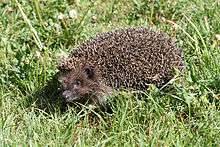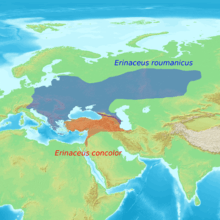Northern white-breasted hedgehog
The northern white-breasted hedgehog (Erinaceus roumanicus[3]) is a species of hedgehog.
| Northern white-breasted hedgehog[1] | |
|---|---|
 | |
| Scientific classification | |
| Kingdom: | Animalia |
| Phylum: | Chordata |
| Class: | Mammalia |
| Order: | Eulipotyphla |
| Family: | Erinaceidae |
| Genus: | Erinaceus |
| Species: | E. roumanicus |
| Binomial name | |
| Erinaceus roumanicus Barrett-Hamilton, 1900 | |
 | |
| Range of the northern white-breasted hedgehog (blue) | |
The range of the species extends in the west as far as Poland, Austria and the former Yugoslavia, and south to Greece and the Adriatic Islands, including populations on Crete, Corfu and Rhodes. It is found eastwards through Russia and Ukraine, as far east as the Ob River in Siberia.[1] It is widespread throughout this range, and there are no signs of a significant population decline.[2]
Taxonomically, it was for a time considered to be a subspecies of E. europaeus, and later a subspecies of E. concolor. Since the 1990s, it has been considered a separate species in its own right, following new genetic and morphological studies, with five subspecies - E. roumanicus roumanicus, E. roumanicus bolkayi, E. roumanicus drozdovskii, E. roumanicus nesiotes, and E. roumanicus pallidus.[1]
The species is a common synanthrope and is known to carry not only the hedgehog tick, Ixodes hexagonus, but also Ixodes ricinus, the most common European tick species.[4]
References
- Wilson, D.E.; Reeder, D.M., eds. (2005). Mammal Species of the World: A Taxonomic and Geographic Reference (3rd ed.). Johns Hopkins University Press. ISBN 978-0-8018-8221-0. OCLC 62265494.
- Insectivore Specialist Group (1996). "Erinaceus roumanicus". IUCN Red List of Threatened Species. 1996. Retrieved 2009-04-07.CS1 maint: ref=harv (link) Database entry includes a brief justification of why this species is of least concern
- Note that this is sometimes given as Erinaceus romanicus
- Dumitrache, Mirabela Oana, et al. “Northern White-Breasted Hedgehogs Erinaceus Roumanicus as Hosts for Ticks Infected with Borrelia Burgdorferi Sensu Lato and Anaplasma Phagocytophilum in Romania.” Ticks and Tick-Borne Diseases, vol. 4, no. 3, 2013, pp. 214–217., doi:10.1016/j.ttbdis.2012.11.010.
| Wikispecies has information related to Erinaceus roumanicus |
